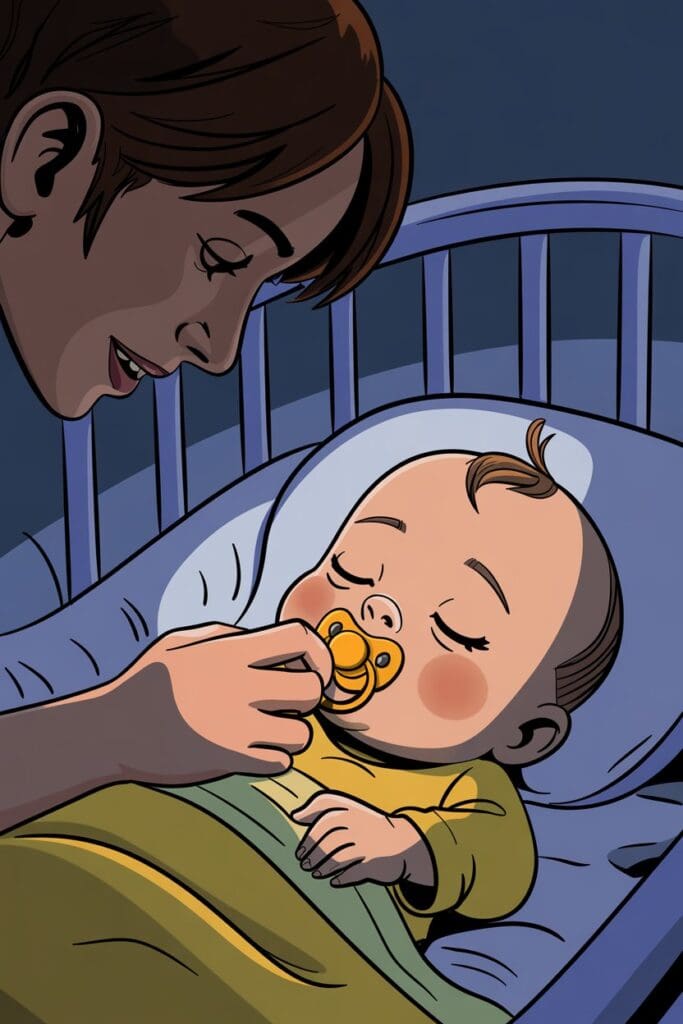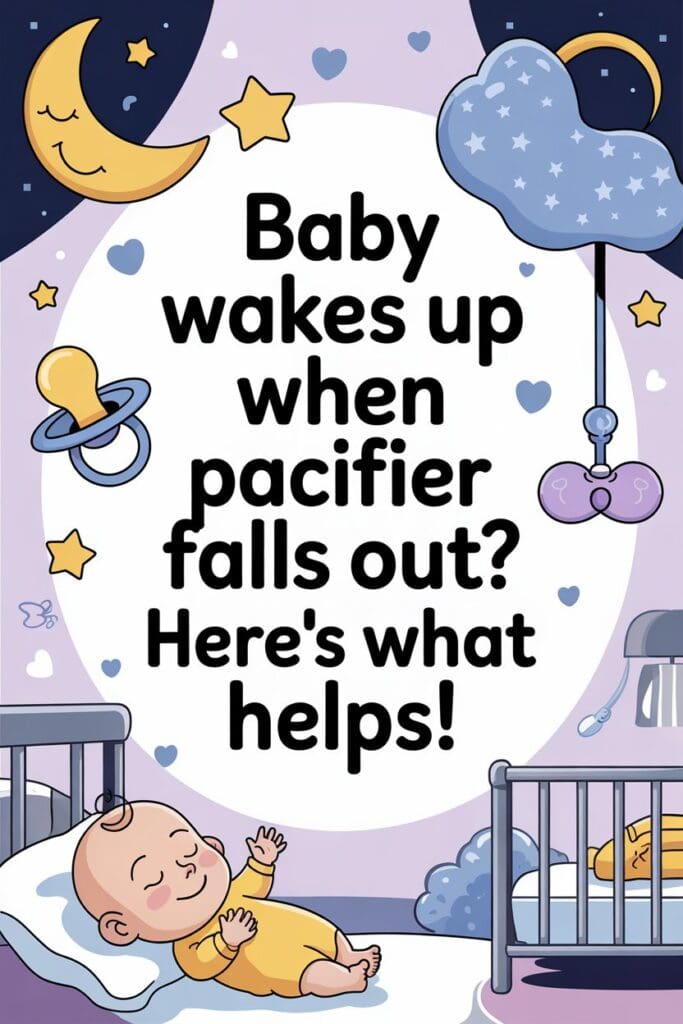Baby Wakes Up When Pacifier Falls Out: Soothing Solutions for Better Sleep
If your baby wakes up every time the pacifier falls out, you’re not alone — and you’re definitely not doing anything wrong.
Many parents struggle with broken sleep because their baby has developed a strong “pacifier-sleep association.”
The good news? You can help your baby sleep longer and more peacefully with some simple strategies.
Let’s dive into why this happens, and more importantly, how to fix it!
Heads up: This post may include affiliate links. As an Amazon Associate, I earn from qualifying purchases—at no extra cost to you. Full privacy policy and disclosure here.

Why Your Baby Wakes Up When the Pacifier Falls Out
1. Sleep Associations
Babies form connections between falling asleep and what was present at the time — like rocking, nursing, or using a pacifier. If they fall asleep with a pacifier in their mouth, they expect it to still be there when they wake up during light sleep cycles.
When the pacifier falls out and it’s missing, they panic and fully wake up, looking for the missing comfort item.
It’s completely normal for a baby to wake up when the pacifier falls out, but you can gently teach better sleep habits over time.
2. Natural Sleep Cycle Changes
Starting around 3–4 months, babies cycle between deeper and lighter sleep stages. During lighter sleep, it’s easier for them to notice changes in their environment — like a missing pacifier.
3. Oral Comfort
Babies instinctively seek oral comfort. If they’re teething or experiencing discomfort, the pacifier becomes even more important for soothing, which makes its absence more disruptive.
How to Help When Baby Wakes Up Without the Pacifier
There are a few different approaches depending on your parenting style and your baby’s age. Here’s how to handle it:
1. Teach Pacifier Re-Insert Skills
For babies around 6–8 months or older, you can start encouraging them to find and replace the pacifier themselves:
- Place multiple pacifiers in the crib (safe styles only).
- During daytime play, practice “find the pacifier” games to build muscle memory.
- At bedtime, help guide their hand to the pacifier when they stir.
With practice, many babies can eventually manage pacifier replacement on their own, leading to fewer full wake-ups.
2. Offer Soothing Without the Pacifier
If your baby is younger or unable to find the pacifier independently yet, you can focus on offering comfort in other ways:
- Gentle back rubbing
- Shushing sounds
- Patting the mattress rhythmically This can gradually weaken the dependency without completely removing comfort.
3. Gradual Weaning From the Pacifier (Optional)
If you prefer, you can gently reduce pacifier dependence altogether:
- Start by offering the pacifier only at naps or nighttime.
- Slowly reduce how often you replace it when it falls out.
- Use other sleep cues like white noise, a lovey (if age-appropriate), or a consistent bedtime routine.
Note: You don’t have to wean from the pacifier if it’s working well overall! Many families keep it through the infant and toddler years without issue.
Many families find that using multiple pacifiers at night reduces wake-ups when the baby wakes up when pacifier falls out.

Is Pacifier Use Safe During Sleep?
Yes — in fact, studies show that pacifier use at sleep times can reduce the risk of Sudden Infant Death Syndrome (SIDS).
However, it’s important to follow safe sleep guidelines:
- Always place baby on their back to sleep.
- Use a one-piece pacifier without extra attachments.
- Don’t reinsert the pacifier if it falls out after the baby is fully asleep (unless you really want to).
Preparing for better sleep? Make sure your diaper bag essentials for newborns include backup pacifiers too!
FAQs: Baby Wakes Up When Pacifier Falls Out
Why does my baby wake up every time the pacifier falls out?
Your baby likely associates falling asleep with having the pacifier in their mouth. When it falls out during a lighter sleep phase, they notice and wake up fully, expecting that familiar comfort.
At what age can babies put the pacifier back in themselves?
Most babies develop the coordination to find and replace their own pacifier between 6–8 months of age. Practicing during the day can speed up this learning process!
Should I keep putting the pacifier back in every time?
It’s up to you! Some parents choose to replace it each time to maximize sleep early on, while others encourage self-soothing or gradual weaning over time to promote more independent sleep habits.
Is it bad for babies to sleep with a pacifier?
No — sleeping with a pacifier is generally considered safe and can even lower SIDS risk. Just be sure the pacifier is clean, one-piece construction, and used according to safe sleep guidelines.
How can I break the pacifier-sleep association gently?
Gradual changes are best:
Offer the pacifier at sleep onset, but don’t rush to replace it during partial wake-ups.
Add other strong sleep cues like white noise or a security object (over 12 months old).
Slowly shift focus away from the pacifier as the primary source of comfort.
Final Thoughts: Helping Your Baby Sleep Better Without Pacifier Drama
It’s tough when your baby wakes up whenever the pacifier falls out — but it’s also normal and solvable.
With a few small changes, you can help your baby develop stronger, more independent sleep habits without sacrificing comfort and security.
During the day, you can strengthen bonding with these simple newborn play activities.
For expert advice on pacifier safety and sleep, visit the American Academy of Pediatrics safe sleep guide.
Remember: every baby is different. Follow your intuition, stay consistent, and celebrate every small step toward better sleep for the whole family. 🌙💤

